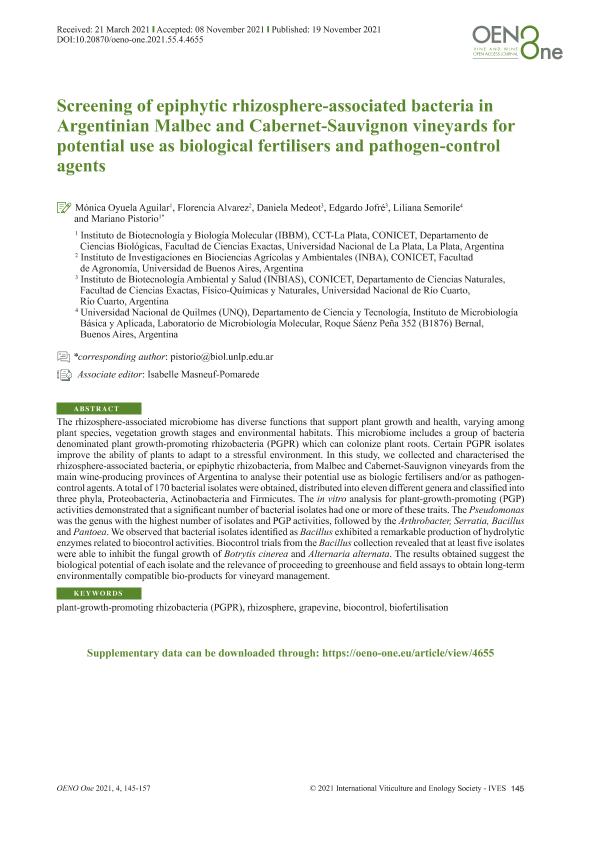Mostrar el registro sencillo del ítem
dc.contributor.author
Oyuela Aguilar, Mónica
dc.contributor.author
Alvarez, Florencia

dc.contributor.author
Medeot, Daniela Beatriz

dc.contributor.author
Jofré, Edgardo

dc.contributor.author
Semorile, Liliana Carmen

dc.contributor.author
Pistorio, Mariano

dc.date.available
2023-01-22T16:20:37Z
dc.date.issued
2021-11-19
dc.identifier.citation
Oyuela Aguilar, Mónica; Alvarez, Florencia; Medeot, Daniela Beatriz; Jofré, Edgardo; Semorile, Liliana Carmen; et al.; Screening of epiphytic rhizosphere-associated bacteria in argentinian malbec and cabernet-sauvignon vineyards for potential use as biological fertilisers and pathogen-control agents; International Viticulture and Enology Society; Oeno One; 55; 4; 19-11-2021; 145-157
dc.identifier.issn
2494-1271
dc.identifier.uri
http://hdl.handle.net/11336/185190
dc.description.abstract
The rhizosphere-associated microbiome has diverse functions that support plant growth and health, varying among plant species, vegetation growth stages and environmental habitats. This microbiome includes a group of bacteria denominated plant growth-promoting rhizobacteria (PGPR) which can colonize plant roots. Certain PGPR isolates improve the ability of plants to adapt to a stressful environment. In this study, we collected and characterised the rhizosphere-associated bacteria, or epiphytic rhizobacteria, from Malbec and Cabernet-Sauvignon vineyards from the main wine-producing provinces of Argentina to analyse their potential use as biologic fertilisers and/or as pathogencontrol agents. A total of 170 bacterial isolates were obtained, distributed into eleven different genera and classified into three phyla, Proteobacteria, Actinobacteria and Firmicutes. The in vitro analysis for plant-growth-promoting (PGP) activities demonstrated that a significant number of bacterial isolates had one or more of these traits. The Pseudomonas was the genus with the highest number of isolates and PGP activities, followed by the Arthrobacter, Serratia, Bacillus and Pantoea. We observed that bacterial isolates identified as Bacillus exhibited a remarkable production of hydrolytic enzymes related to biocontrol activities. Biocontrol trials from the Bacillus collection revealed that at least five isolates were able to inhibit the fungal growth of Botrytis cinerea and Alternaria alternata. The results obtained suggest the biological potential of each isolate and the relevance of proceeding to greenhouse and field assays to obtain long-term environmentally compatible bio-products for vineyard management.
dc.format
application/pdf
dc.language.iso
eng
dc.publisher
International Viticulture and Enology Society
dc.rights
info:eu-repo/semantics/openAccess
dc.rights.uri
https://creativecommons.org/licenses/by-nc-sa/2.5/ar/
dc.subject
BIOCONTROL
dc.subject
BIOFERTILISATION
dc.subject
GRAPEVINE
dc.subject
PLANT-GROWTH-PROMOTING RHIZOBACTERIA (PGPR)
dc.subject
RHIZOSPHERE
dc.subject.classification
Biología Celular, Microbiología

dc.subject.classification
Ciencias Biológicas

dc.subject.classification
CIENCIAS NATURALES Y EXACTAS

dc.title
Screening of epiphytic rhizosphere-associated bacteria in argentinian malbec and cabernet-sauvignon vineyards for potential use as biological fertilisers and pathogen-control agents
dc.type
info:eu-repo/semantics/article
dc.type
info:ar-repo/semantics/artículo
dc.type
info:eu-repo/semantics/publishedVersion
dc.date.updated
2022-09-20T18:39:23Z
dc.journal.volume
55
dc.journal.number
4
dc.journal.pagination
145-157
dc.journal.pais
Francia

dc.description.fil
Fil: Oyuela Aguilar, Mónica. Consejo Nacional de Investigaciones Científicas y Técnicas. Centro Científico Tecnológico Conicet - La Plata. Instituto de Biotecnología y Biología Molecular. Universidad Nacional de La Plata. Facultad de Ciencias Exactas. Instituto de Biotecnología y Biología Molecular; Argentina
dc.description.fil
Fil: Alvarez, Florencia. Consejo Nacional de Investigaciones Científicas y Técnicas. Oficina de Coordinación Administrativa Parque Centenario. Instituto de Investigaciones en Biociencias Agrícolas y Ambientales. Universidad de Buenos Aires. Facultad de Agronomía. Instituto de Investigaciones en Biociencias Agrícolas y Ambientales; Argentina
dc.description.fil
Fil: Medeot, Daniela Beatriz. Universidad Nacional de Rio Cuarto. Facultad de Cs.exactas Fisicoquimicas y Naturales. Instituto de Biotecnologia Ambiental y Salud. - Consejo Nacional de Investigaciones Cientificas y Tecnicas. Centro Cientifico Tecnologico Conicet - Cordoba. Instituto de Biotecnologia Ambiental y Salud.; Argentina
dc.description.fil
Fil: Jofré, Edgardo. Universidad Nacional de Rio Cuarto. Facultad de Cs.exactas Fisicoquimicas y Naturales. Instituto de Biotecnologia Ambiental y Salud. - Consejo Nacional de Investigaciones Cientificas y Tecnicas. Centro Cientifico Tecnologico Conicet - Cordoba. Instituto de Biotecnologia Ambiental y Salud.; Argentina
dc.description.fil
Fil: Semorile, Liliana Carmen. Universidad Nacional de Quilmes. Departamento de Ciencia y Tecnología; Argentina
dc.description.fil
Fil: Pistorio, Mariano. Consejo Nacional de Investigaciones Científicas y Técnicas. Centro Científico Tecnológico Conicet - La Plata. Instituto de Biotecnología y Biología Molecular. Universidad Nacional de La Plata. Facultad de Ciencias Exactas. Instituto de Biotecnología y Biología Molecular; Argentina
dc.journal.title
Oeno One
dc.relation.alternativeid
info:eu-repo/semantics/altIdentifier/url/https://oeno-one.eu/article/view/4655#
dc.relation.alternativeid
info:eu-repo/semantics/altIdentifier/doi/http://dx.doi.org/10.20870/oeno-one.2021.55.4.4655
Archivos asociados
